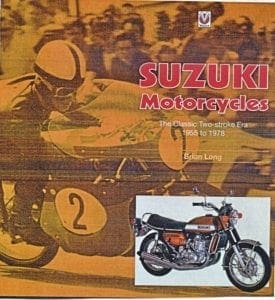Suzuki motorcycles: The Classic Two-Stroke Era 1955 to 1978
Author: Brian Long
Published by: Veloce Publishing Ltd, Veloce House, Parkway Farm Business Park, Middle Farm Way, Poundbury, Dorchester, Dorset DT1 3AR
Tel: 01305 260068 Email: [email protected]: 01305 250479Hardback, 255 x 255mm (landscape); 176 pages with 593 colour and black & white photographs and illustrations.ISBN 978-1- 787112-12-4-7/UPC 6-36847-01212-0£35 (UK); $60 (USA)
Enjoy more Classic MotorCycle reading in the monthly magazine.
Click here to subscribe & save.
Researched and written in Japan by English author Brian Long, with the full co-operation of the factory, here in definitive detail is the story of two-stroke Suzuki motorcycles – a series of models that put the company on the map, helping it to survive a difficult era that saw hundreds of Japanese motorcycle manufacturers reduced to just four.
Michio Suzuki was born in 1887, near Hamamatsu, an area associated with weaving and the manufacture of cloth.
Later, like Coventry in England, many companies moved into cycle and motorcycle production. Trained as an engineer, Michio designed a vastly improved weaving loom for his mother that was so successful that it led to the foundation of the Suzuki Loom Works in 1909 – an industry that ran parallel with Suzuki’s later motorcycle production.
After the Second World War, Suzuki needed to diversify, as transport was desperately required to get the country mobile again. Suzuki’s first machine was launched in 1952, a 32cc powered bicycle called the Power Free, followed shortly by the 58cc Diamond Free model, which was hugely successful.
Suzuki’s first proper motorcycle was introduced in 1953, the Colleda CO, a stylish model with a 125cc side-valve engine. Sales were disappointing, however, and Suzuki adopted two-stroke engines that were cheaper to make and gave better performances, resulting in the 125cc ST that bore more than a passing resemblance to the DKW RT125.
In 1956 came the exciting Colleda 250TT, an impressive two-stroke twin based on the German Adler MB25, with Earles-type front forks.

Three years later came the 125cc Colleda Seltwin, equipped with mirrors and direction indicators, it became the world’s first two-stroke twin with a self-starter. Hydraulically-operated drum brakes were also tried, but unsuccessfully.
After being completely outclassed in the 1961 grands prix world championship season, Suzuki’s prospects changed after they assisted development engineer and GP star Ernst Degner to defect from the MZ team and East Germany, taking with him a great deal of knowledge and information on two-stroke technology.
Suzuki gained many world titles in road racing with Hugh Anderson and Barry Sheene and in motorcross by Joel Robert and Roger De Coster.
With stronger emission laws, 1978 saw the end of Suzuki’s first two-stroke era with such memorable machines as the six-speed Super 6 and the air-cooled three-cylinder GT380 and water-cooled GT750.
Reviewed by Jonathan Hill.
Read Letters, Opinion, News and Features in the February 2020 issue of The Classic Motorcycle – on sale now!
Advert
 Enjoy more The Classic MotorCycle reading in the monthly magazine. Click here to subscribe.
Enjoy more The Classic MotorCycle reading in the monthly magazine. Click here to subscribe.



